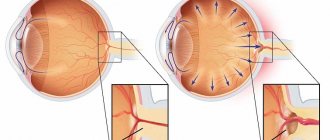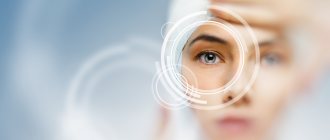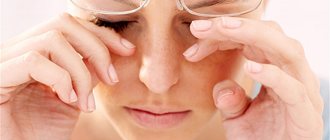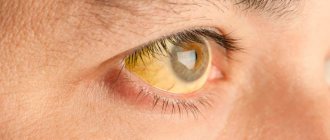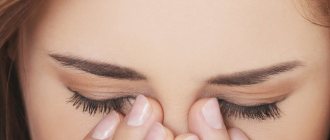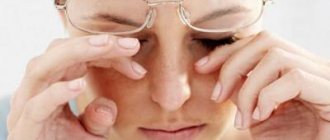Modern people spend more and more time in front of a computer monitor.
Such technology is used for work, entertainment, communication, and many processes and tasks that once took days and weeks are completed in a matter of minutes with the help of computers.
The price to pay for such comfort and time savings is often various diseases , including ophthalmological ones.
Know! Basically, when working at a computer for a long time, a person develops dry eye syndrome and irritation occurs, and such disorders are often accompanied by pain.
Why do computer eyes hurt?
Mechanism of pain:
- A person works at a computer (he sees numbers and text that flicker for a long time).
- The desire to focus leads to increased work.
- Blood flow slows down.
- The brain begins to experience a lack of oxygen.
- The eye vessels dilate and ruptures often occur.
- My head and neck begin to hurt.
Causes of pain:
- Incorrect selection of lenses or glasses. The result is the appearance of “dry eye syndrome”.
- The monitor is poorly positioned. Because of this, muscle fatigue occurs.
- Lack of regular exercise.
- Neglecting safety glasses. The device makes work easier and reduces the load.
- Rare blinking. The person peers intently at the screen, so the usual process is disrupted.
Dryness leads to a lack of oxygen in the tissues, resulting in pain. Ignoring symptoms can provoke the development of ophthalmic pathologies.
Prevention
To prevent unpleasant consequences from working with a computer, it is necessary to streamline this process. You can do it this way:
- arrange the workplace with comfortable furniture so that the chair supports your back and the distance from the eyes to the screen is 30-45 cm;
- monitor posture; when a person hunches over, the blood flow to the brain and internal organs is disrupted, which negatively affects their functioning;
- work with the lights on, in the dark your eyes get tired of the computer faster;
- take regular breaks to exercise for the eyes, back and neck (every 45-60 minutes);
- eat a balanced diet, drink enough water;
- ensure proper rest and healthy sleep (6-9 hours a day).
Preventing headaches is simple, but many people ignore these rules, getting bogged down in work. Taking short breaks every hour will help relax not only your eyes and back, but also the neurons of your brain. This means that you will be much more productive than with a continuous schedule.
What to do if your eyes hurt from the computer
An ophthalmologist treats pathological conditions of the visual organs.
List of symptoms for which examination is considered necessary:
- pain, burning;
- difficulty opening eyelids;
- pronounced redness.
An examination does not allow an accurate diagnosis; it is important to undergo a thorough examination to exclude serious illnesses.
List of studies:
- visual acuity test;
- study of the fundus;
- retinal examination;
- examination of the cornea (special solutions are used).
After the examination, the doctor usually prescribes drops and exercises.
Advantages of drugs:
- relieve fatigue;
- eliminate dryness;
- have a moisturizing effect;
- reduce intraocular pressure;
- serve as a prophylactic against cataracts.
What vitamins solve the problem:
- E (protection from electromagnetic radiation);
- A (relieves discomfort);
- C (strengthens blood vessels, prevents the aging process).
It is important to organize your workplace correctly. Failure to comply with this condition often results in discomfort.
Recommendations:
- the minimum distance to the monitor is 50 centimeters;
- Screen brightness should be moderate;
- a break is taken once every 2 hours (10 minutes is enough time).
During a break, you can do the following exercise: open and close your eyelids several times. Then blink quickly for 1 minute.
Pharmacy products
But what to do if all the above recommendations did not help, and after prolonged work at the computer you feel severe pain, pain and discomfort in your eyes?
Under such circumstances, doctors recommend instilling drops that moisturize the cornea and relieve fatigue.
Such medications help create a tear film and prevent the eyeball from drying out.
These products can be addictive, so if you use them regularly, be sure to alternate between different brands of drops.
Today in pharmacies you can find a huge number of different moisturizing drops that help if your eyes hurt from the computer.
The most effective of them are the following:
- "Stillavit";
- "Zorro";
- "Kuspavit";
- "Reticulin";
- "Hilo-Chest of Drawers";
- "Hilabak";
- "Slezin";
- "Natural tear."
Contrary to widespread belief, Visin drops, which are often used when the computer hurts and waters the eyes, are in fact only an emergency cosmetic remedy. They only mask the signs of visual fatigue and, moreover, can cause harm to the visual system as a whole. That is why it is better to avoid using this popular remedy.
Cold is a way to relieve discomfort
To relieve discomfort, you need to make a special compress with ice.
Algorithm of actions:
- Prepare a decoction of chamomile, add mineral water.
- Pour the liquid into an ice tray.
- Freeze ingredients. You should get cubes.
- Wrap the ice in a cloth and apply to the eyeballs for 2 minutes. Exceeding the time can cause vasospasm and impair blood circulation. It is important to follow the recommendations.
Advantages of the compress:
- relieves tension;
- eliminates the feeling of dryness;
- soothes the mucous membrane;
- relieves redness of the white;
- eliminates pain.
Without time for special gymnastics, it is important to organize a short rest. A great option is to shift your gaze to an object that is in the distance. The method allows you to relieve stress and maintain good vision.
Exercises
If pain occurs, it is not necessary to take medications immediately. Abuse of medications can lead to overuse syndrome. It is more difficult to eliminate compared to tension cephalgia. It is advisable to perform simple manipulations that relax tense muscles and restore tissue trophism.
Simple exercises include:
- You need to straighten your back, straighten your shoulders, lower your chin down and touch your chest. Gradually follows to the starting position.
- The head is turned to the left and stopped for 30 seconds, after which they return to the starting position.
- The exercise is repeated on the other side.
- The head is tilted to the left shoulder, wait 30 minutes, and then return to the starting position.
- The exercise is repeated on the other side.
- The head is pushed forward with the chin several times, and then it is required to return to its original position.
All exercises must be performed not only for cephalalgia. They will be an excellent prevention of unpleasant sensations. Using the complex every hour, you can prevent the onset of pain, as well as improve your condition and reduce fatigue at the end of the day.
What diseases cause eye pain?
Many people have eye pain due to ophthalmological and systemic diseases. The reason may be in the organs of vision or in other disorders. The choice of specialist and treatment depends on the cause of the pain; in order to identify it, laboratory and instrumental examination methods are prescribed.
There are a number of ophthalmological diseases and conditions that can affect soft tissues, blood vessels, and nerves located in the organs of vision.
They cause acute and chronic pain:
- Increased eye strain. It occurs in people who spend a long time in front of a computer, phone, TV, or tablet. Pain occurs when reading books frequently in poor conditions, for example, in low light.
- Entry of a foreign body. It can penetrate the cornea due to strong winds, sparks from a welding machine, or for other reasons. Acute pain, redness, photophobia, increased sensitivity, and spasm of the eyelids occur.
- Conjunctivitis. It can be of an allergic, bacterial, viral nature. This is a disease in which the conjunctiva of the eye becomes inflamed. Redness, swelling, pain, and photophobia appear. With bacterial conjunctivitis, purulent exudate is released.
- Blepharitis is inflammation of the eyelids. It can develop due to the proliferation of fungi, viruses, bacteria, parasites (eyelash mites). The eyelids swell and an abscess filled with fluid may form under the skin.
- Keratitis is inflammation of the cornea. The inflammatory process begins as a result of mechanical damage, burns, and the proliferation of pathogenic microorganisms. If the disease lasts a long time, the cornea becomes cloudy and visual acuity decreases.
- Glaucoma is an increase in intraocular pressure due to impaired outflow of secreted fluid. There are anterior and posterior chambers in the eyeball, and fluid constantly circulates inside them. If it accumulates but does not come out, the pressure increases. This can lead to damage to the optic nerve, retinal detachment, and blindness.
- Retinal diseases. They develop due to burns, mechanical damage, and malnutrition through blood vessels. If the retina detaches, the person goes blind.
- Diseases of the optic nerve. Light streams pass through the eyes, hitting the rods and cones of the retina. From them, information in the form of nerve impulses passes through the nerve, entering the brain. The nerve is damaged due to malnutrition through blood vessels, mechanical damage, and infectious and inflammatory processes.
- Strabismus, amblyopia. If both eyes see the picture in front of them incorrectly, this leads to increased strain. As a result, not only your eyes hurt, but also your head.
There are diseases that develop not in the eyes, but in peripheral organs; with their prolonged development, complications arise from the organs of vision, this also leads to pain:
- Diabetes. A large amount of glucose accumulates in the patient’s blood, which is not distributed to the tissues, but binds to cholesterol and forms plaques. They are transported through large and small vessels, including the microcirculation of the eyes. This leads to blockage, severe pain, decreased or complete absence of vision.
- Atherosclerosis. Cholesterol accumulates in the patient’s blood, which spreads through the vessels, clogging their lumen. The mechanism of the disease is the same as for diabetes mellitus.
- Arterial hypertension. Increased pressure puts stress on the endothelium. This leads to rupture of the vessel wall and hemorrhage inside the eyeball. With chronic hypertension, the function of the visual organs decreases, and constant headaches and eye pain occur.
- Ischemic disease. A person experiences spasm of peripheral vessels. If this happens in the eyes, nutrition is disrupted. Gradually, the visual organs will stop working. Severe spasm causes severe pain.
- Vasculitis, increased fragility of blood vessels. If the endothelium is fragile, this leads to hemorrhage in any part of the body. Painful sensations appear during spasms, which causes a decrease in vision function.
- Neuropathy. The inflammatory disease can spread to the optic nerve, this is dangerous because it connects to the brain. This causes a decrease in its functionality and constant pain.
For each disease, a separate treatment is determined. Therefore, diagnostics are initially carried out, identifying the nature of pain, decreased vision function and other symptoms.
How to properly install a monitor
Pain in the eyes is caused by excessive tension. After all, you have to keep track of small letters, graphs, and images that are constantly changing. Your eyes get especially tired when typing texts.
Accordingly, the source of danger is the computer monitor. It must be installed correctly and located at a sufficient distance from it. So, the normal distance is 60–70 cm from the monitor. The location of the monitor is also important. It is highly undesirable for it to be at an angle. After all, then even looking at him will be uncomfortable.
This position of the eyes in itself will cause severe pain. Often it is the incorrect placement of the monitor that causes pain. Therefore, you need to place it so that the screen is directly opposite your eyes or as shown in the picture above.
Return to contents
First aid if something gets in your eyes
If a foreign object gets into the eye, provide first aid. If there is minor damage, this can be done at home. But if blepharospasm or extensive damage occurs, contact an ophthalmologist or traumatologist.
First aid is carried out in several stages:
- Anesthesia. It is used if the patient is unable to open his eyes. Use solutions of lidocaine and novocaine. They are dripped in limited quantities, as they cause side effects with prolonged action.
- The person is placed in a dark room to reduce the strain on the visual organs. This eliminates photophobia and the patient can open the eyelids.
- Washing. It is better to use an antiseptic solution. Furacilin is suitable for this. Dissolve 1 tablet in a glass of water. Pharmacies sell ready-made solutions. The drug is instilled directly into the eyes. If this does not help, liquid is poured into the cup, and the victim lowers his open eyes into it. The fluid inside is blinked to remove the foreign body from the mucous membrane.
- If a foreign body causes a burn, you cannot do without the help of a doctor. He will remove the foreign object using ophthalmic instruments.
- Antibiotic instillation. This step is required to exclude a bacterial infection. The medicine is used for up to 7 days. They use Vigamox, Tobrex.
After completing first aid, the person is discharged home. There he must continue therapy. Ointments are used that improve the regeneration of damaged tissue, for example, Solcoseryl or Korneregel.
Anti-inflammatory drugs are used to relieve redness and swelling. For example, Visin. You can use it for no more than 4 days, after which it becomes addictive.
1 week after completing home treatment, return to see an ophthalmologist. He checks the functional condition of the eyes and assesses the degree of wound healing. If complications arise, he adjusts treatment methods.
When providing first aid, it is prohibited to try to remove a foreign object using your fingers. Cold and hot water should not be used for rinsing, as the cornea is irritated; warm solutions are used.
It is recommended to consult a doctor after removing the foreign body yourself. There are cases when the mucous membrane is damaged, so a bacterial infection penetrates into it.
In what cases should you consult a doctor?
A doctor is always consulted if the patient uses treatment for 1 week, but the discomfort does not go away. This may mean the presence of a disease that the person does not know about.
There are symptoms for which you should not self-medicate:
- severe swelling of the eyelids, which completely covers the cornea;
- lack of pupillary reflex to bright light;
- different pupil sizes;
- hemorrhage in the cornea, visible visually;
- severe pain in which the patient cannot open the eyelids;
- extensive suppuration, in which the antibiotic does not help; perhaps the microorganisms are resistant to the active substance;
- a sharp deterioration in health (rise in body temperature, weakness, fatigue, lethargy);
- immediate decrease in vision;
- burn, mechanical damage.
Providing first aid at home with further failure to see a doctor will lead to a deterioration in health, decreased visual acuity, and complications.
Acupressure
With this type of cephalalgia, stimulation of biologically active points is sometimes sufficient. Usually it is enough to massage your temples by moving your fingers towards your hair. This must be done simultaneously on both sides, moving in the same direction for 10-15 seconds. The pressure should be light.
Stimulation of areas behind the ears at the level of the lobes has a good effect. To ensure maximum positive effect, the procedure should be completed by massaging the area in the occipital cavity at the base of the skull. If you use essential peppermint or menthol oil, the treatment will be even better.
What bad habits are associated with eye pain?
Bad habits that lead to impaired vision include smoking, alcoholism, and drug addiction. All toxic substances negatively affect blood vessels and nerve tissue.
Smoking reduces the flow of oxygen through the lungs into the blood. This causes hypoxia of organs, including the eyes. Smoking reduces the elasticity of the vascular endothelium. It becomes brittle, so in addition to hypoxia, the risk of hemorrhage increases.
With daily alcohol intake, ethanol accumulates in the blood and various tissues. It is toxic and leads to dysfunction of the nervous tissue (optic nerve, visual center of the brain).
Drugs destroy all tissues with which they interact. If they are used for a long time, they accumulate in the brain and optic nerve. This reduces visual acuity. Drugs disrupt the conduction of nerve impulses from cones and rods through the optic nerve to the brain. Lack of pupillary reflex is common.
Bad habits include prolonged use of electronic gadgets. They create a strain on the eyes, as the gaze concentrates only on nearby objects.



